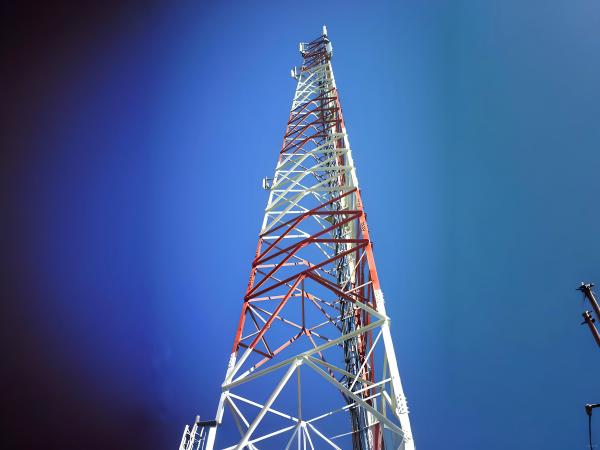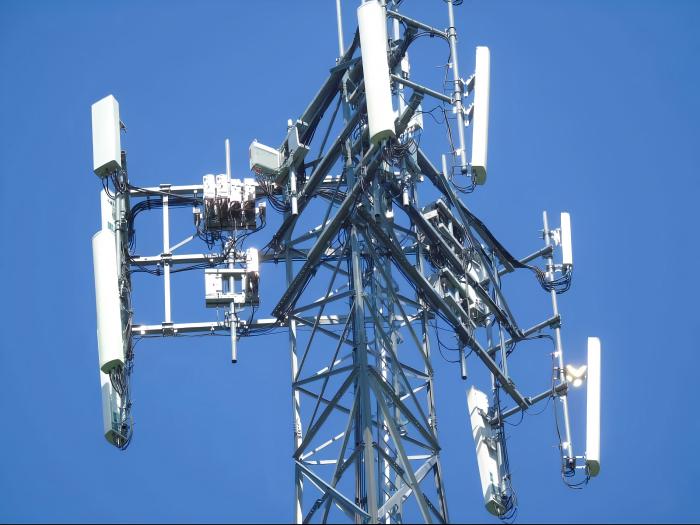–Ґ–µ—Е–љ–Є—З–µ—Б–Ї–Њ–µ –њ—А–Њ–µ–Ї—В–Є—А–Њ–≤–∞–љ–Є–µ —В—А—С—Е–Њ–њ–Њ—А–љ—Л—Е –≤—Л—И–µ–Ї –і–ї—П –Љ–љ–Њ–≥–Њ–Њ–њ–µ—А–∞—В–Њ—А—Б–Ї–Є—Е —А–∞–Ј–≤—С—А—В—Л–≤–∞–љ–Є–є —Б–µ—В–µ–є 5G
Sep 15, 2025
-–Т–≤–µ–і–µ–љ–Є–µ
–Я–µ—А–µ—Е–Њ–і –Ї 5G —В—А–µ–±—Г–µ—В –љ–∞–і–µ–ґ–љ–Њ–є –Є–љ—Д—А–∞—Б—В—А—Г–Ї—В—Г—А—Л, —Б–њ–Њ—Б–Њ–±–љ–Њ–є –њ–Њ–і–і–µ—А–ґ–Є–≤–∞—В—М –±–Њ–ї–µ–µ –≤—Л—Б–Њ–Ї–Є–µ —З–∞—Б—В–Њ—В—Л, –Љ–∞—Б—Б–Є–≤–љ—Л–µ –∞–љ—В–µ–љ–љ—Л MIMO –Є —Б–Њ–≤–Љ–µ—Б—В–љ–Њ–µ –Є—Б–њ–Њ–ї—М–Ј–Њ–≤–∞–љ–Є–µ —А–µ—Б—Г—А—Б–Њ–≤ –љ–µ—Б–Ї–Њ–ї—М–Ї–Є–Љ–Є –Њ–њ–µ—А–∞—В–Њ—А–∞–Љ–Є. –°—А–µ–і–Є —А–∞–Ј–ї–Є—З–љ—Л—Е –Ї–Њ–љ—Б—В—А—Г–Ї—Ж–Є–є –≤—Л—И–µ–Ї –њ—А–µ–і–њ–Њ—З—В–Є—В–µ–ї—М–љ—Л–Љ –≤–∞—А–Є–∞–љ—В–Њ–Љ —Б—В–∞–ї–Є —В—А–µ—Е–Њ–њ–Њ—А–љ—Л–µ —Г–≥–ї–Њ–≤—Л–µ —Б—В–∞–ї—М–љ—Л–µ –≤—Л—И–Ї–Є –±–ї–∞–≥–Њ–і–∞—А—П –Є—Е –Є—Б–Ї–ї—О—З–Є—В–µ–ї—М–љ–Њ–є –њ—А–Њ—З–љ–Њ—Б—В–Є, —Г—Б—В–Њ–є—З–Є–≤–Њ—Б—В–Є –Є –Љ–∞—Б—И—В–∞–±–Є—А—Г–µ–Љ–Њ—Б—В–Є. –Т —Н—В–Њ–є —Б—В–∞—В—М–µ —А–∞—Б—Б–Љ–∞—В—А–Є–≤–∞—О—В—Б—П —В–µ—Е–љ–Є—З–µ—Б–Ї–Є–µ –Њ—Б–Њ–±–µ–љ–љ–Њ—Б—В–Є –Ї–Њ–љ—Б—В—А—Г–Ї—Ж–Є–Є, –Ї–Њ—В–Њ—А—Л–µ –і–µ–ї–∞—О—В —Н—В–Є –≤—Л—И–Ї–Є –Є–і–µ–∞–ї—М–љ—Л–Љ–Є –і–ї—П –Љ–љ–Њ–≥–Њ–Њ–њ–µ—А–∞—В–Њ—А—Б–Ї–Є—Е —А–∞–Ј–≤–µ—А—В—Л–≤–∞–љ–Є–є 5G, —Б –∞–Ї—Ж–µ–љ—В–Њ–Љ –љ–∞ –≥—А—Г–Ј–Њ–њ–Њ–і—К–µ–Љ–љ–Њ—Б—В—М, —Б—В—А—Г–Ї—В—Г—А–љ—Г—О –∞–і–∞–њ—В–Є–≤–љ–Њ—Б—В—М –Є –њ–µ—А—Б–њ–µ–Ї—В–Є–≤–љ–Њ—Б—В—М.

1. –Ч–∞—З–µ–Љ –љ—Г–ґ–љ—Л —В—А–µ—Е–љ–Њ–≥–Є–µ –≤—Л—И–Ї–Є –і–ї—П 5G?
–Ґ—А–µ—Г–≥–Њ–ї—М–љ–∞—П –≥–µ–Њ–Љ–µ—В—А–Є—П —В—А—С—Е–Њ–њ–Њ—А–љ—Л—Е –±–∞—И–µ–љ –Њ–±–µ—Б–њ–µ—З–Є–≤–∞–µ—В —Г—Б—В–Њ–є—З–Є–≤–Њ—Б—В—М –Є —Н—Д—Д–µ–Ї—В–Є–≤–љ—Г—О –љ–µ—Б—Г—Й—Г—О —Б–њ–Њ—Б–Њ–±–љ–Њ—Б—В—М. –Ф–ї—П —А–∞–Ј–≤—С—А—В—Л–≤–∞–љ–Є–є —Б–µ—В–µ–є 5G, –≥–і–µ –≤–µ—Б –∞–љ—В–µ–љ–љ—Л –Є –≤–µ—В—А–Њ–≤–∞—П –љ–∞–≥—А—Г–Ј–Ї–∞ –Ј–љ–∞—З–Є—В–µ–ї—М–љ–Њ –≤–Њ–Ј—А–∞—Б—В–∞—О—В, —Н—В–∞ –Ї–Њ–љ—Б—В—А—Г–Ї—Ж–Є—П –Њ–±–µ—Б–њ–µ—З–Є–≤–∞–µ—В:
-
–Я—А–µ–≤–Њ—Б—Е–Њ–і–љ–∞—П —Г—Б—В–Њ–є—З–Є–≤–Њ—Б—В—М –Ї –Њ–њ—А–Њ–Ї–Є–і—Л–≤–∞—О—Й–Є–Љ –Љ–Њ–Љ–µ–љ—В–∞–Љ:
–Ґ—А–µ—Г–≥–Њ–ї—М–љ—Л–µ –Њ—Б–љ–Њ–≤–∞–љ–Є—П —А–∞–≤–љ–Њ–Љ–µ—А–љ–Њ —А–∞—Б–њ—А–µ–і–µ–ї—П—О—В –Љ–µ—Е–∞–љ–Є—З–µ—Б–Ї–Є–µ –љ–∞–≥—А—Г–Ј–Ї–Є.
-
–Р–і–∞–њ—В–∞—Ж–Є—П –Ї –±–Њ–ї—М—И–Є–Љ –љ–∞–≥—А—Г–Ј–Ї–∞–Љ:
–°–њ–Њ—Б–Њ–±–љ–∞ –њ–Њ–і–і–µ—А–ґ–Є–≤–∞—В—М –Њ–±–Њ—А—Г–і–Њ–≤–∞–љ–Є–µ –љ–µ—Б–Ї–Њ–ї—М–Ї–Є—Е –Њ–њ–µ—А–∞—В–Њ—А–Њ–≤ –±–µ–Ј —Г—Й–µ—А–±–∞ –і–ї—П –Ї–Њ–љ—Б—В—А—Г–Ї—Ж–Є–Є.
-
–Я—А–Њ—Б—В–Њ—В–∞ —Г—Б—В–∞–љ–Њ–≤–Ї–Є –Є –Њ–±—Б–ї—Г–ґ–Є–≤–∞–љ–Є—П:
–Ь–Њ–і—Г–ї—М–љ–∞—П –Ї–Њ–љ—Б—В—А—Г–Ї—Ж–Є—П —Г–њ—А–Њ—Й–∞–µ—В —Б–±–Њ—А–Ї—Г –Є –Љ–Њ–і–µ—А–љ–Є–Ј–∞—Ж–Є—О.
2. –Ъ–ї—О—З–µ–≤—Л–µ —В–µ—Е–љ–Є—З–µ—Б–Ї–Є–µ —Б–Њ–Њ–±—А–∞–ґ–µ–љ–Є—П –њ–Њ –њ—А–Њ–µ–Ї—В–Є—А–Њ–≤–∞–љ–Є—О
2.1 –Р–љ–∞–ї–Є–Ј –≥—А—Г–Ј–Њ–њ–Њ–і—К–µ–Љ–љ–Њ—Б—В–Є
–†–∞–Ј–≤–µ—А—В—Л–≤–∞–љ–Є–µ —Б–µ—В–µ–є 5G —В—А–µ–±—Г–µ—В –Є—Б–њ–Њ–ї—М–Ј–Њ–≤–∞–љ–Є—П –±–Њ–ї–µ–µ —В—П–ґ—С–ї—Л—Е –∞–љ—В–µ–љ–љ (–љ–∞–њ—А–Є–Љ–µ—А, –Љ–∞—Б—Б–Є–≤–љ—Л—Е MIMO-–Љ–Њ–і—Г–ї–µ–є), –±–Њ–ї—М—И–µ–≥–Њ –Ї–Њ–ї–Є—З–µ—Б—В–≤–∞ –Њ–±–Њ—А—Г–і–Њ–≤–∞–љ–Є—П –Є –±–Њ–ї–µ–µ –≤—Л—Б–Њ–Ї–Є—Е –≤–µ—В—А–Њ–≤—Л—Е –љ–∞–≥—А—Г–Ј–Њ–Ї. –Т—Л—И–Ї–∞ –і–Њ–ї–ґ–љ–∞ –±—Л—В—М —Б–њ—А–Њ–µ–Ї—В–Є—А–Њ–≤–∞–љ–∞ —Б —Г—З—С—В–Њ–Љ:
-
–°–Њ–±—Б—В–≤–µ–љ–љ–∞—П –љ–∞–≥—А—Г–Ј–Ї–∞:
–Т–µ—Б —Б–∞–Љ–Њ–є –±–∞—И–љ–Є, –∞–љ—В–µ–љ–љ, –ї–Є–љ–Є–є —Н–ї–µ–Ї—В—А–Њ–њ–µ—А–µ–і–∞—З–Є –Є –њ–ї–∞—В—Д–Њ—А–Љ.
-
–Ц–Є–≤–∞—П –љ–∞–≥—А—Г–Ј–Ї–∞:
–Т–µ—Б –Њ–±—Б–ї—Г–ґ–Є–≤–∞—О—Й–µ–≥–Њ –њ–µ—А—Б–Њ–љ–∞–ї–∞ –Є –Є–љ—Б—В—А—Г–Љ–µ–љ—В–Њ–≤.
-
–Э–∞–≥—А—Г–Ј–Ї–Є –љ–∞ –Њ–Ї—А—Г–ґ–∞—О—Й—Г—О —Б—А–µ–і—Г:
-
–Т–µ—В—А–Њ–≤–∞—П –љ–∞–≥—А—Г–Ј–Ї–∞: —Б–∞–Љ–∞—П –±–Њ–ї—М—И–∞—П –њ–µ—А–µ–Љ–µ–љ–љ–∞—П. –†–∞—Б—Б—З–Є—В—Л–≤–∞–µ—В—Б—П —Б –Є—Б–њ–Њ–ї—М–Ј–Њ–≤–∞–љ–Є–µ–Љ —В–∞–Ї–Є—Е —Б—В–∞–љ–і–∞—А—В–Њ–≤, –Ї–∞–Ї TIA-222-G –Є–ї–Є EN 1993-3-1, —Б —Г—З—С—В–Њ–Љ —Б–Ї–Њ—А–Њ—Б—В–Є –≤–µ—В—А–∞, –њ–ї–Њ—Й–∞–і–Є –њ–Њ–≤–µ—А—Е–љ–Њ—Б—В–Є –∞–љ—В–µ–љ–љ—Л –Є –≤—Л—Б–Њ—В—Л –≤—Л—И–Ї–Є.
-
–Ы–µ–і—П–љ–∞—П –љ–∞–≥—А—Г–Ј–Ї–∞: –Ї—А–Є—В–Є—З–µ—Б–Ї–Є –≤–∞–ґ–љ–∞ –≤ —Е–Њ–ї–Њ–і–љ–Њ–Љ –Ї–ї–Є–Љ–∞—В–µ; –љ–∞–Ї–Њ–њ–ї–µ–љ–Є–µ –ї—М–і–∞ –љ–∞ –∞–љ—В–µ–љ–љ–∞—Е –Є –±–∞—И–љ—П—Е —Г–≤–µ–ї–Є—З–Є–≤–∞–µ—В –≤–µ—Б –Є —Б–Њ–њ—А–Њ—В–Є–≤–ї–µ–љ–Є–µ –≤–µ—В—А—Г.
--–Я—А–Є–Љ–µ—А —А–∞—Б—З–µ—В–∞ –љ–∞–≥—А—Г–Ј–Ї–Є:
30-–Љ–µ—В—А–Њ–≤–∞—П —В—А–µ—Е–Њ–њ–Њ—А–љ–∞—П –≤—Л—И–Ї–∞ –≤ –њ—А–Є–±—А–µ–ґ–љ–Њ–Љ —А–∞–є–Њ–љ–µ (—Б–Ї–Њ—А–Њ—Б—В—М –≤–µ—В—А–∞ 50 –Љ/—Б) —Б —И–µ—Б—В—М—О –∞–љ—В–µ–љ–љ–∞–Љ–Є 5G Massive MIMO –љ–∞ –Њ–њ–µ—А–∞—В–Њ—А–∞ –Љ–Њ–ґ–µ—В –њ–Њ—В—А–µ–±–Њ–≤–∞—В—М—Б—П –і–ї—П –њ–Њ–і–і–µ—А–ґ–Ї–Є:
-
–Э–∞–≥—А—Г–Ј–Ї–∞ –љ–∞ –∞–љ—В–µ–љ–љ—Г: ~600 –Ї–≥
-
–Т–µ—В—А–Њ–≤–∞—П –љ–∞–≥—А—Г–Ј–Ї–∞: ~15 –Ї–Э
-
–Ы–µ–і–Њ–≤–∞—П –љ–∞–≥—А—Г–Ј–Ї–∞: ~200 –Ї–≥ (–µ—Б–ї–Є –њ—А–Є–Љ–µ–љ–Є–Љ–Њ)

2.2 –Ґ–µ—Е–љ–Є—З–µ—Б–Ї–Є–µ —Г—Б–ї–Њ–≤–Є—П –љ–∞ —Б—В—А—Г–Ї—В—Г—А–љ–Њ–µ –њ—А–Њ–µ–Ї—В–Є—А–Њ–≤–∞–љ–Є–µ
-
–Т—Л–±–Њ—А –Љ–∞—В–µ—А–Є–∞–ї–∞: –≤—Л—Б–Њ–Ї–Њ–њ—А–Њ—З–љ–∞—П —Б—В–∞–ї—М (–љ–∞–њ—А–Є–Љ–µ—А, Q345 –Є–ї–Є ASTM A572) —Б –Љ–Є–љ–Є–Љ–∞–ї—М–љ—Л–Љ –њ—А–µ–і–µ–ї–Њ–Љ —В–µ–Ї—Г—З–µ—Б—В–Є 345 –Ь–Я–∞.
-
–Ч–∞—Й–Є—В–∞ –Њ—В –Ї–Њ—А—А–Њ–Ј–Є–Є: –≥–Њ—А—П—З–µ–µ —Ж–Є–љ–Ї–Њ–≤–∞–љ–Є–µ –њ–Њ —Б—В–∞–љ–і–∞—А—В—Г ASTM A123 –і–ї—П –і–Њ–ї–≥–Њ–≤–µ—З–љ–Њ—Б—В–Є –≤ —Б—Г—А–Њ–≤—Л—Е —Г—Б–ї–Њ–≤–Є—П—Е.
-
–°–Њ–µ–і–Є–љ–µ–љ–Є—П: –±–Њ–ї—В–Њ–≤—Л–µ —Б–Њ–µ–і–Є–љ–µ–љ–Є—П –і–ї—П —Г–і–Њ–±—Б—В–≤–∞ —Б–±–Њ—А–Ї–Є –Є –±—Г–і—Г—Й–Є—Е –Љ–Њ–і–Є—Д–Є–Ї–∞—Ж–Є–є.
-
–§—Г–љ–і–∞–Љ–µ–љ—В: –ґ–µ–ї–µ–Ј–Њ–±–µ—В–Њ–љ–љ—Л–є —Д—Г–љ–і–∞–Љ–µ–љ—В, —Б–њ–Њ—Б–Њ–±–љ—Л–є –њ—А–Њ—В–Є–≤–Њ—Б—В–Њ—П—В—М –њ–Њ–і—К–µ–Љ–љ—Л–Љ –Є –Њ–њ—А–Њ–Ї–Є–і—Л–≤–∞—О—Й–Є–Љ —Б–Є–ї–∞–Љ.
2.3 –Ъ–Њ–љ—Д–Є–≥—Г—А–∞—Ж–Є—П —Б –љ–µ—Б–Ї–Њ–ї—М–Ї–Є–Љ–Є –Њ–њ–µ—А–∞—В–Њ—А–∞–Љ–Є
–Ф–ї—П —А–∞–Ј–Љ–µ—Й–µ–љ–Є—П –љ–µ—Б–Ї–Њ–ї—М–Ї–Є—Е –Њ–њ–µ—А–∞—В–Њ—А–Њ–≤ –±–∞—И–љ—П –і–Њ–ї–ґ–љ–∞ –≤–Љ–µ—Й–∞—В—М:
-
–Ь–µ—Б—В–∞ —Г—Б—В–∞–љ–Њ–≤–Ї–Є –∞–љ—В–µ–љ–љ—Л:
–Э–µ—Б–Ї–Њ–ї—М–Ї–Њ –њ–ї–∞—В—Д–Њ—А–Љ –љ–∞ —А–∞–Ј–љ–Њ–є –≤—Л—Б–Њ—В–µ, —З—В–Њ–±—Л –Є–Ј–±–µ–ґ–∞—В—М –њ–Њ–Љ–µ—Е.
-
–£–њ—А–∞–≤–ї–µ–љ–Є–µ –Ї–∞–±–µ–ї—П–Љ–Є:
–Т—Л–і–µ–ї–µ–љ–љ—Л–µ –њ—Г—В–Є –і–ї—П –Њ–њ—В–Њ–≤–Њ–ї–Њ–Ї–Њ–љ–љ—Л—Е –Є —Н–ї–µ–Ї—В—А–Њ–њ—А–Њ–≤–Њ–і–љ—Л—Е –ї–Є–љ–Є–є, –њ–Њ–Ј–≤–Њ–ї—П—О—Й–Є–µ –Є–Ј–±–µ–ґ–∞—В—М –±–µ—Б–њ–Њ—А—П–і–Ї–∞ –Є –Њ–±–µ—Б–њ–µ—З–Є—В—М –±–µ–Ј–Њ–њ–∞—Б–љ–Њ—Б—В—М.
-
–†–∞—Б–њ—А–µ–і–µ–ї–µ–љ–Є–µ –≤–µ—Б–∞:
–Я—А–Є –њ—А–Њ–µ–Ї—В–Є—А–Њ–≤–∞–љ–Є–Є –Ї–Њ–љ—Б—В—А—Г–Ї—Ж–Є–Є –љ–µ–Њ–±—Е–Њ–і–Є–Љ–Њ —Г—З–Є—В—Л–≤–∞—В—М –∞—Б–Є–Љ–Љ–µ—В—А–Є—З–љ—Г—О –љ–∞–≥—А—Г–Ј–Ї—Г.
3. –Я—А–Њ–±–ї–µ–Љ—Л –њ—А–Њ–µ–Ї—В–Є—А–Њ–≤–∞–љ–Є—П, —Б–≤—П–Ј–∞–љ–љ—Л–µ —Б 5G
-
–Ь–∞—Б—Б–Є–≤–љ—Л–µ –∞–љ—В–µ–љ–љ—Л MIMO:
–Ю–љ–Є –Ї—А—Г–њ–љ–µ–µ –Є —В—П–ґ–µ–ї–µ–µ –њ—А–µ–і—Л–і—Г—Й–Є—Е –њ–Њ–Ї–Њ–ї–µ–љ–Є–є. –Ю–і–Є–љ –Љ–∞—Б—Б–Є–≤–љ—Л–є MIMO-–Љ–Њ–і—Г–ї—М –Љ–Њ–ґ–µ—В –≤–µ—Б–Є—В—М 20вАУ30 –Ї–≥, –∞ –љ–∞ –Њ–і–љ–Њ–є –≤—Л—И–Ї–µ –Є—Е –Љ–Њ–≥—Г—В —А–∞–Ј–Љ–µ—Й–∞—В—М—Б—П –і–µ—Б—П—В–Ї–Є.
-
–Ф–Є–љ–∞–Љ–Є–Ї–∞ –≤–µ—В—А–Њ–≤–Њ–є –љ–∞–≥—А—Г–Ј–Ї–Є:
–С–Њ–ї—М—И–∞—П –њ–ї–Њ—Й–∞–і—М –њ–Њ–≤–µ—А—Е–љ–Њ—Б—В–Є –∞–љ—В–µ–љ–љ 5G —Г–≤–µ–ї–Є—З–Є–≤–∞–µ—В –≤–µ—В—А–Њ–≤—Г—О –љ–∞–≥—А—Г–Ј–Ї—Г, —З—В–Њ —В—А–µ–±—Г–µ—В –±–Њ–ї–µ–µ –њ—А–Њ—З–љ—Л—Е –±–∞—И–µ–љ –Є —Д—Г–љ–і–∞–Љ–µ–љ—В–Њ–≤.
-
–І–∞—Б—В–Њ—В–љ—Л–µ –њ–Њ–Љ–µ—Е–Є:
–Р–љ—В–µ–љ–љ—Л –і–Њ–ї–ґ–љ—Л –±—Л—В—М —А–∞–Ј–љ–µ—Б–µ–љ—Л –≤–Њ –Є–Ј–±–µ–ґ–∞–љ–Є–µ –њ–Њ–Љ–µ—Е, –≤–ї–Є—П—О—Й–Є—Е –љ–∞ –≤—Л—Б–Њ—В—Г –≤—Л—И–Ї–Є –Є –Ї–Њ–љ—Б—В—А—Г–Ї—Ж–Є—О –њ–ї–∞—В—Д–Њ—А–Љ—Л.
4. –Я—А–Є–Љ–µ—А: —А–∞–Ј–≤–µ—А—В—Л–≤–∞–љ–Є–µ –Љ–љ–Њ–≥–Њ–Њ–њ–µ—А–∞—В–Њ—А—Б–Ї–Њ–є –≤—Л—И–Ї–Є 5G
–Ю–±–Ј–Њ—А –њ—А–Њ–µ–Ї—В–∞: 35-–Љ–µ—В—А–Њ–≤–∞—П —В—А–µ—Е–Њ–њ–Њ—А–љ–∞—П –±–∞—И–љ—П –≤ –≥–Њ—А–Њ–і—Б–Ї–Њ–є –Ј–Њ–љ–µ –і–ї—П —А–∞–Ј–Љ–µ—Й–µ–љ–Є—П —В—А–µ—Е –Њ–њ–µ—А–∞—В–Њ—А–Њ–≤ –Љ–Њ–±–Є–ї—М–љ–Њ–є —Б–≤—П–Ј–Є.

5. –°—В–∞–љ–і–∞—А—В—Л –Є —Б–Њ–Њ—В–≤–µ—В—Б—В–≤–Є–µ
-
–Ь–µ–ґ–і—Г–љ–∞—А–Њ–і–љ—Л–µ —Б—В–∞–љ–і–∞—А—В—Л:
-
TIA-222-G: –°—В—А—Г–Ї—В—Г—А–љ—Л–µ —Б—В–∞–љ–і–∞—А—В—Л –і–ї—П –Њ–њ–Њ—А–љ—Л—Е –Ї–Њ–љ—Б—В—А—Г–Ї—Ж–Є–є –∞–љ—В–µ–љ–љ.
-
EN 1993-3-1: –Х–≤—А–Њ–њ–µ–є—Б–Ї–Є–є —Б—В–∞–љ–і–∞—А—В –њ—А–Њ–µ–Ї—В–Є—А–Њ–≤–∞–љ–Є—П –±–∞—И–µ–љ –Є –Љ–∞—З—В.
-
–°–µ–є—Б–Љ–Є—З–µ—Б–Ї–Є–µ –Є —Ж–Є–Ї–ї–Њ–љ–Є—З–µ—Б–Ї–Є–µ —Б—В–∞–љ–і–∞—А—В—Л:
–†–µ–≥–Є–Њ–љ–∞–ї—М–љ—Л–µ –љ–Њ—А–Љ—Л –Є –њ—А–∞–≤–Є–ї–∞ (–љ–∞–њ—А–Є–Љ–µ—А, ISO 3010 –і–ї—П —Б–µ–є—Б–Љ–Є—З–µ—Б–Ї–Њ–≥–Њ –њ—А–Њ–µ–Ї—В–Є—А–Њ–≤–∞–љ–Є—П).
6. –Я—А–Њ–µ–Ї—В–Є—А–Њ–≤–∞–љ–Є–µ, –Њ—А–Є–µ–љ—В–Є—А–Њ–≤–∞–љ–љ–Њ–µ –љ–∞ –±—Г–і—Г—Й–µ–µ
-
–Р–і–∞–њ—В–Є—А—Г–µ–Љ–Њ—Б—В—М –Ї 6G:
–С–∞—И–љ–Є –і–Њ–ї–ґ–љ—Л –±—Л—В—М —Б–њ—А–Њ–µ–Ї—В–Є—А–Њ–≤–∞–љ—Л —Б —Г—З–µ—В–Њ–Љ —А–∞–Ј–Љ–µ—Й–µ–љ–Є—П –µ—Й–µ –±–Њ–ї–µ–µ —В—П–ґ–µ–ї—Л—Е –Є –Ї—А—Г–њ–љ—Л—Е –∞–љ—В–µ–љ–љ.
-
–Ш–љ—В–µ–≥—А–∞—Ж–Є—П –Ш–љ—В–µ—А–љ–µ—В–∞ –≤–µ—Й–µ–є:
–Я–Њ–і–і–µ—А–ґ–Ї–∞ –і–∞—В—З–Є–Ї–Њ–≤ (–љ–∞–њ—А–Є–Љ–µ—А, –Љ–Њ–љ–Є—В–Њ—А–Є–љ–≥–∞ —Б–Њ—Б—В–Њ—П–љ–Є—П –Ї–Њ–љ—Б—В—А—Г–Ї—Ж–Є–Є) –і–ї—П –Њ–±–µ—Б–њ–µ—З–µ–љ–Є—П –њ—А–Њ–≥–љ–Њ—Б—В–Є—З–µ—Б–Ї–Њ–≥–Њ –Њ–±—Б–ї—Г–ґ–Є–≤–∞–љ–Є—П.
-
–£—Б—В–Њ–є—З–Є–≤–Њ—Б—В—М:
–Ш—Б–њ–Њ–ї—М–Ј–Њ–≤–∞–љ–Є–µ –њ–µ—А–µ—А–∞–±–Њ—В–∞–љ–љ–Њ–є —Б—В–∞–ї–Є –Є –Ї–Њ–љ—Б—В—А—Г–Ї—Ж–Є–є, –Љ–Є–љ–Є–Љ–Є–Ј–Є—А—Г—О—Й–Є—Е —А–∞—Б—Е–Њ–і –Љ–∞—В–µ—А–Є–∞–ї–∞ –±–µ–Ј —Г—Й–µ—А–±–∞ –і–ї—П –њ—А–Њ—З–љ–Њ—Б—В–Є.
–Ч–∞–Ї–ї—О—З–µ–љ–Є–µ
–Ґ—А—С—Е—Б—В–Њ–µ—З–љ–∞—П —Г–≥–ї–Њ–≤–∞—П —Б—В–∞–ї—М–љ–∞—П –±–∞—И–љ—П вАФ —В–µ—Е–љ–Є—З–µ—Б–Ї–Є –љ–∞–і—С–ґ–љ–Њ–µ —А–µ—И–µ–љ–Є–µ –і–ї—П –Љ–љ–Њ–≥–Њ–Њ–њ–µ—А–∞—В–Њ—А—Б–Ї–Є—Е —А–∞–Ј–≤—С—А—В—Л–≤–∞–љ–Є–є —Б–µ—В–µ–є 5G. –Х—С –Ї–Њ–љ—Б—В—А—Г–Ї—Ж–Є—П –Њ–±–µ—Б–њ–µ—З–Є–≤–∞–µ—В —Н—Д—Д–µ–Ї—В–Є–≤–љ–Њ–µ —Б–Њ—З–µ—В–∞–љ–Є–µ –љ–∞–≥—А—Г–Ј–Њ—З–љ–Њ–є —Б–њ–Њ—Б–Њ–±–љ–Њ—Б—В–Є, —Б—В—А—Г–Ї—В—Г—А–љ–Њ–є —Ж–µ–ї–Њ—Б—В–љ–Њ—Б—В–Є –Є –∞–і–∞–њ—В–Є–≤–љ–Њ—Б—В–Є, —З—В–Њ –і–µ–ї–∞–µ—В –µ—С –Є–і–µ–∞–ї—М–љ—Л–Љ —А–µ—И–µ–љ–Є–µ–Љ –і–ї—П –≤—Л—Б–Њ–Ї–Є—Е —В—А–µ–±–Њ–≤–∞–љ–Є–є —Б–Њ–≤—А–µ–Љ–µ–љ–љ—Л—Е —Б–µ—В–µ–є. –°–Њ–±–ї—О–і–∞—П –Љ–µ–ґ–і—Г–љ–∞—А–Њ–і–љ—Л–µ —Б—В–∞–љ–і–∞—А—В—Л –Є –Њ—А–Є–µ–љ—В–Є—А—Г—П—Б—М –љ–∞ –±—Г–і—Г—Й–µ–µ, –Њ–њ–µ—А–∞—В–Њ—А—Л —Б–µ—В–µ–є –Љ–Њ–≥—Г—В –≥–∞—А–∞–љ—В–Є—А–Њ–≤–∞—В—М –ґ–Є–Ј–љ–µ—Б–њ–Њ—Б–Њ–±–љ–Њ—Б—В—М —Б–≤–Њ–µ–є –Є–љ—Д—А–∞—Б—В—А—Г–Ї—В—Г—А—Л –љ–∞ –і–µ—Б—П—В–Є–ї–µ—В–Є—П –≤–њ–µ—А—С–і.
–£–Ј–љ–∞–є—В–µ –±–Њ–ї—М—И–µ –љ–∞
www.alttower.com
–°–≤—П–Ј–∞—В—М—Б—П —Б –љ–∞–Љ–Є
 –ѓ–Ј—Л–Ї
–ѓ–Ј—Л–Ї
 English
English fran√Іais
fran√Іais espa√±ol
espa√±ol ЎІўДЎєЎ±Ў®ўКЎ©
ЎІўДЎєЎ±Ў®ўКЎ©











 –Я–Њ–і–і–µ—А–ґ–Є–≤–∞–µ—В—Б—П —Б–µ—В—М IPv6
–Я–Њ–і–і–µ—А–ґ–Є–≤–∞–µ—В—Б—П —Б–µ—В—М IPv6